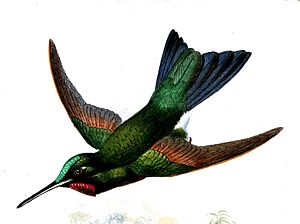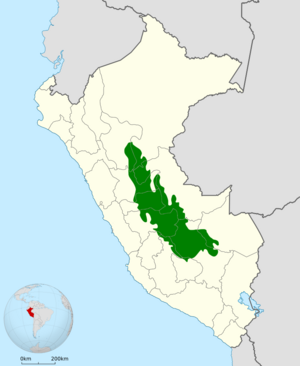Rufous-webbed brilliant facts for kids
Quick facts for kids Rufous-webbed brilliant |
|
|---|---|
 |
|
| Conservation status | |
| Scientific classification | |
| Genus: |
Heliodoxa
|
| Species: |
branickii
|
 |
|
The rufous-webbed brilliant (Heliodoxa branickii) is a type of hummingbird. It belongs to a group of hummingbirds called "brilliants." This amazing bird lives only in Peru, which means it is endemic to that country.
Contents
Meet the Rufous-Webbed Brilliant Hummingbird
What's in a Name?
Scientists give every living thing a special name. For this hummingbird, its scientific name is Heliodoxa branickii. It used to have a different scientific name, Lampraster, but scientists decided it fit better with the Heliodoxa group. This bird is also "monotypic," which means it's the only species in its specific group.
How to Spot This Bird
The rufous-webbed brilliant is a small bird, about 11 to 11.5 cm (4.3 to 4.5 in) long. That's about the length of your hand! Male birds weigh around 5.8 g (0.20 oz), and females are a bit lighter at 5.4 g (0.19 oz).
You can tell this hummingbird apart by its special wing feathers. The inner part of its wings is a warm cinnamon-red color, which is where it gets the "rufous-webbed" part of its name. The rest of its wings are dark. Both male and female birds have a black beak, which is lighter at the bottom.
- Male Rufous-Webbed Brilliant:
- Mostly shiny dark green.
- Its forehead is a brighter, sparkling green.
- It has a beautiful, shimmery rosy patch on its throat, called a gorget.
- The feathers under its tail are bright white.
- The two middle tail feathers are green, and the others are dark blue.
- Female Rufous-Webbed Brilliant:
- Also has shiny dark green feathers on its back, sides, and chest.
- There's a short white stripe from its beak to just below its eye.
- Its throat and chest are white, with shiny green tips on the feathers.
- Its belly is white to light brown.
- Females usually don't have the rosy throat patch, or if they do, it's lighter and more yellowish than the male's.
- Like the males, their undertail feathers are bright white, but the blue outer tail feathers have white tips.
Where Does It Live?
The rufous-webbed brilliant hummingbird has been found mostly on the eastern side of the Andes mountains in central and southern Peru. There have been a few reports of it in Bolivia, but these haven't been fully confirmed yet.
This hummingbird likes to live inside and at the edges of wet mountain forests. You can find it at elevations between 650 and 1,700 m (2,100 and 5,600 ft) above sea level.
How It Behaves
Daily Life
Scientists are still learning about the rufous-webbed brilliant's movements. We don't know if it travels to different places during the year.
What It Eats
This hummingbird mainly sips nectar from flowers found in the lower parts of the forest and along its edges. While we know it loves nectar, we don't know all the specific types of flowers it visits. It also eats small insects, which give it important protein.
Life Cycle
Not much is known about how the rufous-webbed brilliant breeds. Scientists haven't yet documented its nesting habits or how it raises its young.
Sounds It Makes
The rufous-webbed brilliant has a unique song. It's described as a series of "chew" notes mixed with a short, fast, downward-sounding trill. Its call is a sweet, descending "tew" sound.
Is This Bird Safe?
The IUCN (International Union for Conservation of Nature) has listed the rufous-webbed brilliant as a species of "Least Concern." This means that, for now, it's not considered to be in immediate danger of disappearing.
Even though it has a large area where it lives, we don't know exactly how many of these birds there are. Scientists believe their numbers might be slowly going down. Luckily, no specific threats have been identified that are causing a big problem for them.
In Peru, where it lives, the bird is seen as uncommon to fairly common. It can handle some changes to its home, like if the forest is a bit broken up or disturbed. However, if large parts of the forest are completely cleared away, it could cause the number of these hummingbirds in those areas to drop.


